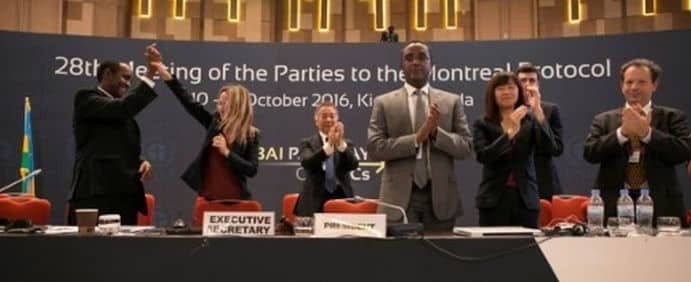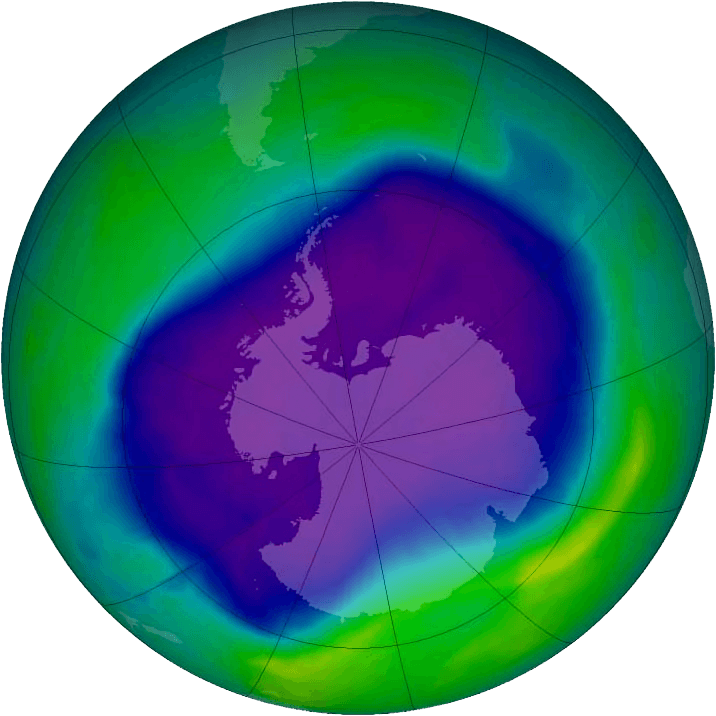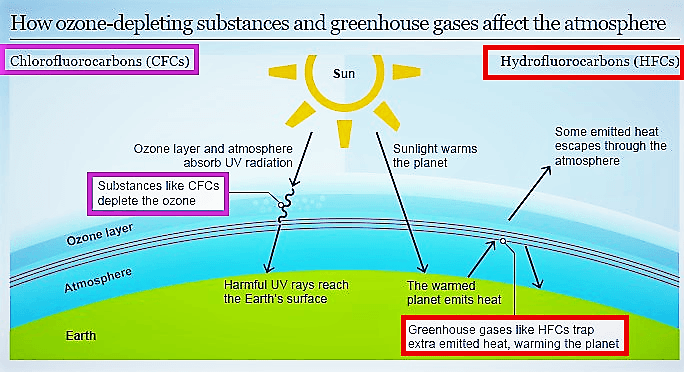Kigali Agreement explained
Various agreements were made by nations across the world to protect environment and to curb ozone layer depletion. For example, the Paris agreement, the Montreal protocol was some of the environmental treaties to overcome the climate changes. Apart from all these agreements, what makes the Kigali agreement different? What is the significance of Kigali agreement?
This article goes through each aspect of the agreement and its relevance and how it differs from other agreements.
Kigali Agreement – An Overview
Basically, Kigali agreement can be viewed as an amendment to Montreal protocol. The agreement took place in Kigali, the capital city of tiny African country, Rwanda, on 15th October, 2016. Almost 197 countries around the globe, including developed and developing countries joined together to limit the Hydro fluorocarbon [HFCs] emission to a certain extent.
Further, reduction in manufacture and use of HFCs will considerably reduce global temperature rise by 2100.
The Montreal Protocol
The Montreal protocol was signed on 16th September, 1987 and it came into force on 1st January, 1989. Latter, it underwent various revisions over the years and Kigali agreement being the latest. The Montreal protocol was mainly for substances that deplete the ozone layer. An international treaty to protect ozone layer, including 197 nations making it the first universally ratified treaties.
As a result of Montreal protocol, atmospheric concentrations of chlorofluorocarbons [CFCs], has declined drastically. However, the use of HFCs has boomed over the same period. Its mostly because of the fact that CFCs were substituted with HFCs. Overall, the Montreal protocol has a positive impact on environment as evidenced by a stark decline of ozone depleting substances in the atmosphere.
Kigali Agreement- Objectives
197 countries came to an agreement to phase out a potential group of green house gas by the end of 2040, thereby prevent 0.5 Celsius temperature rise by the end of the century.
Important aspects of Kigali Agreement
-
197 countries with a set time limit
197 countries around the planet including India, China and the United States signed Kigali Agreement. Further these nations set a timeline to phase out the use of HFCs to 85% of their baselines by 2045.
-
Not only ozone layer depletion, but also reduce global warming
This agreement is significant as it amends Montreal protocol in 1987. The Montreal protocol was focusing only on substances responsible for ozone layer depletion and thereby reducing its use. On the other hand, the Kigali agreement is pointing out towards green house gases that are responsible for global warming. Hence, this agreement is significant in protection of ozone layer as well as to reduce global warming.
-
Cool the world by the end of this century
Another important aspect of this agreement is to cap global warming well below 2 degree Celsius by 2100. Furthermore, it plans to reduce prevent a potential 0.5 degree Celsius rise in global temperature. Therefore, reduction in global warming coupled with prevention of temperature rise can cool the planet by the end of this century.
- 197 countries, three groups with different timelines for reduction
- First group comprises of the richest countries, including the US and nations in the European Union. There target is to freeze the production and consumption of HFCs by 2018. Moreover, these countries aim to reduce these green house gas levels to about 15% of 2012 levels, by 2036.
- Second group of countries includes China, Brazil and whole of African continent. They will freeze HFC use by 2024 reducing it up to 20% of 2021 levels by 2045.
Third group include developing economies as well as some of the hottest countries like India, Pakistan, Saudi Arabia, Bahrain. These nations will be freezing HFC use by 2028 and plans to reduce about 15% of 2025 levels by 2047.
-
A global initiative to mitigate climate change
The Kigali agreement is a reaffirmation of global initiative to mitigate climatic change. By reducing the use and consumption of potent green house gases across the world, this will reduce the climate change, rising sea levels and so on. Eventually World will have enough food supply due to an increase in agricultural production,by tackling the issue of climatic change. Therefore, this agreement is a global initiative to safeguard world’s food production.
-
A breakthrough for replacing noxious substance with other alternatives
This agreement is the biggest step taken to tackle various issues related to climatic change. Along with this, it gives a clear message to global markets to start substituting noxious substances with environment friendly and energy efficient alternatives. This will create a revolutionary change in all fields and the world will be switched to renewable sources of energy.
HFCs and its impact on global warming
Hydro fluorocarbons are a group of organic compounds that contains carbon, fluorine and hydrogen. Chlorofluorocarbon were responsible for ozone depletion. So HFCs there introduced in markets as a replacement to Chlorofluocarbons. HFCs are commonly used in refrigerators and air conditioners. According to the recent studies without a mitigation plan, these gases will warm up the world by additional half degree Celsius by the end of the century. Even though, HFCs have zero ozone depletion potential [ODP], they contribute significantly to global warming. Common HFCs include trifluoromethane [HFC-23], difluoromethane [HFC-32], fluoromethane [HFC-41] and so on.
Also read : Western Ghats: Geographical features, biodiversity and its conservation.
India and Kigali agreement
India whole heartedly welcomed Kigali agreement and extended its flexibility and cooperation along with other nations. Along with other global compacts on environmental issues, India pressed for a lenient deadline. Ultimately, India agreed to freeze HFC use in 2028, four years later than its peer countries like China, Brazil etc. Moreover, India will achieve maximum reduction by 2047, two years later than India’s peer groups.
However, in a welcome contrast to Kigali agreement, India has ordered the manufactures of HFC-23, to capture and dispose it off this potential gas at their own cost. HFC-23 is a by- product of a chemical used in refrigerant manufacture and it significantly contributes to green house effect. As the living standards of the people in India are increasing, therefore, people will expand the use of refrigerator and air conditioners and this will emit more HFC into atmosphere. Thus the decision of disposing of HFC -23 is of great significance.
One of the biggest challenge before India is with regards to ‘Make in India’ projects. India should shift to green technologies to remain themselves competent in global markets. Therefore, India should switch to other sources of HFCs, sooner than the anticipated period. Besides this, India can become more attractive in global markets with the reduced cost of green technology. This changeover, however, will have a long term positive impact on the nation. Apart from this, the Kigali agreement will provide a mechanism for accessing and developing technologies that leave a low carbon foot print.
Also read :Analysis of India’s air pollution problem
Along with these, financial aids coupled with technological aids from the rich countries, for the achievement of green technology in industries, will enable India to explore more in natural resources.
References :
- Wikipedia.
- The Hindu.
- Indian Express.
- UNEP.









Leave a Reply